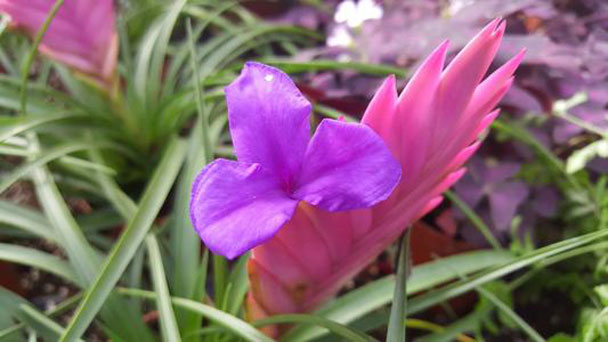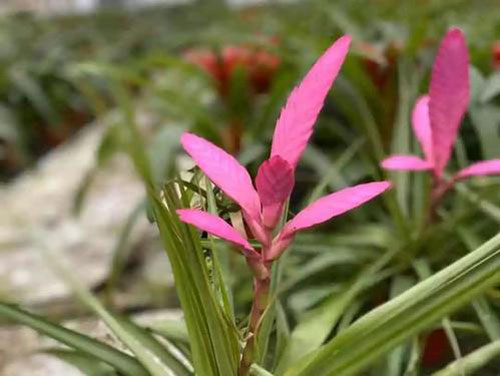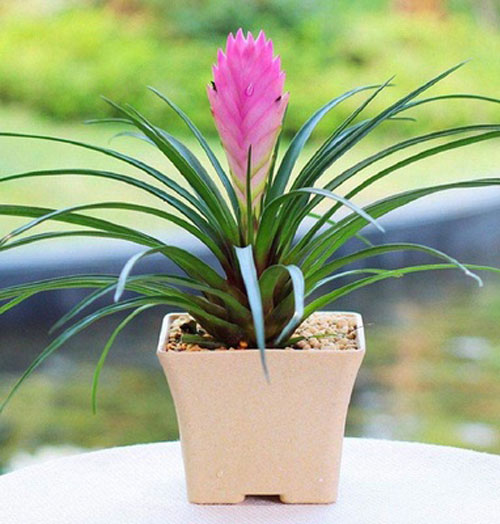Tillandsia Cyanea (Pink Quill Plant) Grow & Care Guide
Written by Iris
Sep 07 2021

Tillandsia Cyanea is a plant with high ornamental value. The mature Tillandsia Cyanea grows to a height of 30 to 40 cm, which is very cute. Its leaves grow linearly. The length of the leaves is between 20 cm and 30 cm, and the width is between 1 cm and 1.5 cm. The flowering period of Tillandsia Cyanea is also very long, and the flowering period can be maintained for half a month when it is properly cultivated. Now let me tell you how to grow and care for Tillandsia Cyanea.
Remove your tillandsia cyanea from the mounting board, using wire cutters and pliers if necessary. Place the plant in a bowl of water for two or three hours to hydrate it.
Remove the Tillandsia Cyanea from the water and move the plant to a flat work surface. Gently spread the leaves of the plant to reveal the pups at its base. Work the leaves apart with your fingers to locate where the plants are connected.
Separate the pups from the parent plant by gently pulling the plants apart at the base. The leaves may break if you pull from the top. Put the pups into the bowl of water as you separate them from the parent plant.
Remount the parent Tillandsia Cyanea to the growing board. Mount the pups with crafting wire to the same board if there is room for continuous air circulation between the plants. If the plants will be crowded, mount the pups on a separate board. Set the mounted plants in a location with bright light or outdoors in warmer climates.
Mist the pups each day, in the morning or early afternoon. Tillandsia Cyanea is nocturnal and respires at night, which means they breathe in carbon dioxide at night. If the leaves are covered with a film of water, they cannot absorb the gas from the air.
Pink quill plants will grow well in a mixture of sphagnum moss and epiphytic mix. This growing medium allows the plant to tolerate frequent watering and extend their roots.
Alternatively, you could plant your pink quill in orchid bark or in a cymbidium mix.
When planting your Tillandsia Cyanea plants, make sure you give them enough room to expand. It is not uncommon for these plants to produce up to 10-12 offshoots. However, this can take several years.
It doesn't need as much watering as a typical houseplant but you should be looking to water whenever the soil becomes dry. This may mean a good watering every couple of weeks, more in very hot weather and less in Winter. When in doubt its better to underwater than overwater these plants. 
The bracts remain pink for many weeks after the flowers had faded. When flowers fade, you should remove them.
In the mid 20th century, a hybrid of Tillandsia cyanea and Tillandsia lindenni was created by D. Barry. This cross is called Tillandsia Emilie. Reportedly, the Tillandsia Emilie is more robust and easier to grow than the Pink Quill or Tillandsia lindenni.
Why My Pink Quill plants have No flowers?
Pink Quill plants that don't bloom aren't getting enough light. Move your plant closer to a window, but out of hot, direct midday sun. keep this tropical native warm, too. It needs a temperature of about 75°F/24°C to flower.
How to Grow Tillandsia Cyanea (Pink Quill)Tillandsia Cyanea Propagation with SeedsTillandsia Cyanea Propagation with OffsetsTillandsia Cyanea CareLight RequirementsSoil CareWateringTemperature & Humidity CareFertilizerPruningPests & Diseases CareTillandsia Cyanea (Pink Quill) FAQAre the Tillandsia Cyanea Plants Poisonous?When Does Tillandsia Cyanea Bloom and Flower?Tillandsia cyanea vs Tillandsia lindennii?
How to Grow Tillandsia Cyanea (Pink Quill)
Tillandsia Cyanea Propagation with Seeds
Plants of the Tillandsia genus can be propagated by seeds. Find some moss and Thuja twigs, mix them together and form a bundle. Tie the bundle up with a wire or a string, and place the seeds into the bundle. Sprinkle it with water, let it hang in moderate-light place with a good air circulation, and mist it occasionally until seeds germinate. You can propagate Tillandsia Cyanea from seed, but it takes two to four years to grow the plant to a suitable size for enjoyment.Tillandsia Cyanea Propagation with Offsets
Tillandsia Cyanea plants (Pink Quills) are easy to propagate from through their offsets. Known as 'pups,' they readily grow at the base of a healthy and mature plant. When they reach at least three inches in length, they can be cut from the mother plant and potted into a porous medium. It can take up to six months for them to fully establish their own roots.Remove your tillandsia cyanea from the mounting board, using wire cutters and pliers if necessary. Place the plant in a bowl of water for two or three hours to hydrate it.
Remove the Tillandsia Cyanea from the water and move the plant to a flat work surface. Gently spread the leaves of the plant to reveal the pups at its base. Work the leaves apart with your fingers to locate where the plants are connected.
Separate the pups from the parent plant by gently pulling the plants apart at the base. The leaves may break if you pull from the top. Put the pups into the bowl of water as you separate them from the parent plant.
Remount the parent Tillandsia Cyanea to the growing board. Mount the pups with crafting wire to the same board if there is room for continuous air circulation between the plants. If the plants will be crowded, mount the pups on a separate board. Set the mounted plants in a location with bright light or outdoors in warmer climates.
Mist the pups each day, in the morning or early afternoon. Tillandsia Cyanea is nocturnal and respires at night, which means they breathe in carbon dioxide at night. If the leaves are covered with a film of water, they cannot absorb the gas from the air.

Tillandsia Cyanea Care
Light Requirements
You need to avoid direct sunlight to prevent the Tillandsia Cyanea leaves burning, but good indirect light is needed for the quickly growth of young plants to a flowering size. However, if your Tillandsia cyanea plant is already in flower or you do not intend to keep your Tillandsia Cyanea around after flowering has finished then less light is fine.Soil Care
Tillandsia Cyanea (Pink Quill) is unique among tillandsias in that they prefer to be grown in a well-draining growing medium rather than epiphytically. Although, they will survive if grown epiphytically. When they are grown in soil, they will develop a robust root system.Pink quill plants will grow well in a mixture of sphagnum moss and epiphytic mix. This growing medium allows the plant to tolerate frequent watering and extend their roots.
Alternatively, you could plant your pink quill in orchid bark or in a cymbidium mix.
When planting your Tillandsia Cyanea plants, make sure you give them enough room to expand. It is not uncommon for these plants to produce up to 10-12 offshoots. However, this can take several years.
Watering
The majority of plants belonging to the Tillandsia genus such as the Air Plants don't need much water, however the Tillandsia Cyanea does need quite a bit more to do really well. They can be chlorine sensitive so if you are able, provide rain or bottled water instead of tap water.It doesn't need as much watering as a typical houseplant but you should be looking to water whenever the soil becomes dry. This may mean a good watering every couple of weeks, more in very hot weather and less in Winter. When in doubt its better to underwater than overwater these plants.
Temperature & Humidity Care
Average room temperatures 65-75°F/18-24°C suit this tropical bromeliad. Average room (around 40% relative humidity). Brown tips on leaves are a result of dry air. The most efficient way to raise the humidity for Tillandsia Cyanea is with a cool-mist room humidifier.Fertilizer
Feeding Tillandsia Cyanea plants aren't always necessary for healthy plants. Many enthusiasts, however, will feed their plant once in the spring and once in the summer. There are foliar fertilizer sprays developed especially for Tillandsia species.Pruning
The flower spike can be cutted off when it has dried. The old growth will not bloom again. After flowering Tillandsia Cyanea is showing new offsets at its base. Those will maybe rebloom after some months.Pests & Diseases Care
The Tillandsia Cyanea isn't known for having any major problems with pests or diseases. Occasionally aphids can be an issue, but there are several ways you can tackle their removal, including washing them off and applying insecticidal soaps.
Tillandsia Cyanea (Pink Quill) FAQ
Are the Tillandsia Cyanea Plants Poisonous?
Like most Bromeliads, the Tillandsia Cyanea is not poisonous to people or pets such as cats and dogs.When Does Tillandsia Cyanea Bloom and Flower?
Tillandsia Cyanea will bloom once it's reached maturity. When blooming time arrives, once green bracts become bright pink or even red. Bright violet-blue flowers with three petals occur on the edges of the pink bracts in spring or autumn, but they last very shortly, only for several days. These flowers are 5cm (2 in) big.The bracts remain pink for many weeks after the flowers had faded. When flowers fade, you should remove them.
Tillandsia cyanea vs Tillandsia lindennii?
As unique as Pink Quills are, they have a “look alike.” Tillandsia lindennii looks very similar to the Pink Quill, but they are a bit larger. Pink Quill will grow to a height of 10-12 inches. In contrast, the Tillandsia lindennii will grow taller than 16 inches. Tillandsia lindennii is a little more tolerant of cold than Pink Quill.In the mid 20th century, a hybrid of Tillandsia cyanea and Tillandsia lindenni was created by D. Barry. This cross is called Tillandsia Emilie. Reportedly, the Tillandsia Emilie is more robust and easier to grow than the Pink Quill or Tillandsia lindenni.
Why My Pink Quill plants have No flowers?
Pink Quill plants that don't bloom aren't getting enough light. Move your plant closer to a window, but out of hot, direct midday sun. keep this tropical native warm, too. It needs a temperature of about 75°F/24°C to flower.

Latest Updated
- Benefits of Bugleweed - 7 Science-backed Health Benefits
- Bugleweed Dangers & Side Effects - Is It Poisonous?
- How to Plant Evergreen Trees - What You Should Know
- When to Plant Evergreens - Grow Guide for Evergreen Trees
- 12 Wonderful Evergreen Shrubs for Your Garden
- 12 Popular Evergreen Plants with Pictures for Beginners
- When And How To Prune A Lilac Bush Like a Pro
- How to Grow & Care for Lilac Vine (Hardenbergia Violacea)
- Japanese Lilac Tree (Syringa Reticulata) Care & Propagation Guide
- Shumard Oak Pros and Cons - What to Know
Popular Articles
- Winter maintenance of Antirrhinum Majus
- How to Grow Terminalia Mantaly Tree
- How to Grow and Care for Crossostephium Chinense
- How to grow Antirrhinum Majus in spring
- Peristeria Elata (Dove Orchid) Profile: Info & Care Guide
- Underwatered Snake Plant (Sansevieria Trifasciata) - Signs And How To Fix
- How to Care for Brazilian Jasmine Plant (Mandevilla Sanderi)
- How to Grow & Care for Graptopetalum Purple Delight in Summer
- Rosa Chinensis (China Rose): Plant Growing & Care Tips
- How to Care for Baby Sun Rose (Aptenia Cordifolia)